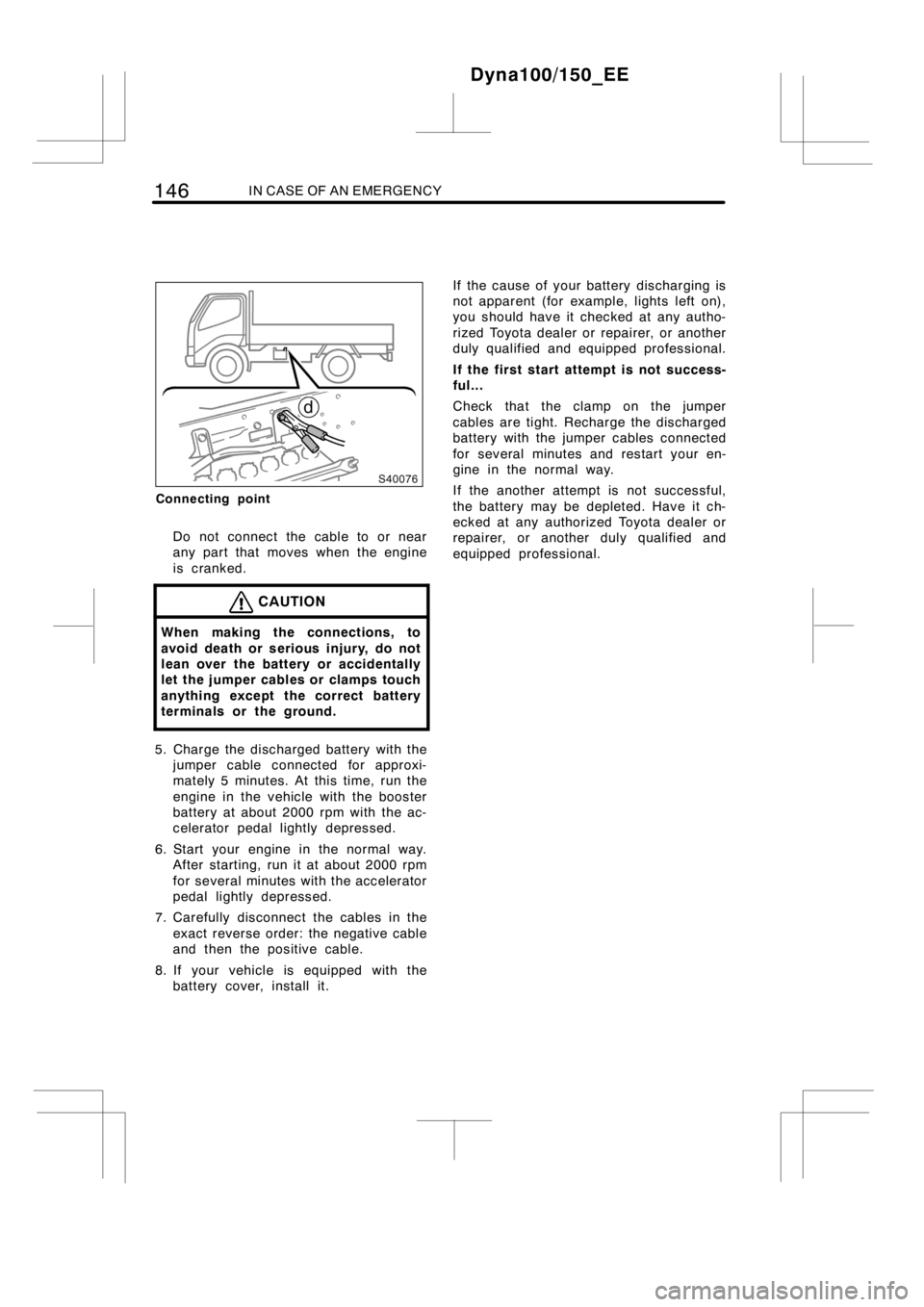2014 TOYOTA DYNA 100/150 jump start
[x] Cancel search: jump startPage 136 of 232

130STARTING AND DRIVING
Keep the door locks from freezing.
Squirt lock de−icer or glycerine into the
locks to keep them from freezing. To open
a frozen lock, try heating the key before
inserting it.
Use a washer fluid containing an anti-
freeze solution.
This product is available at any authorized
Toyota dealer or repairer and most auto
parts stores or another qualified professio-
nal. Follow the manufacturer ’s directions
for how much to mix with water.
NOTICE
Do not use engine antifreeze or any
other substitute because it may dam-
age your vehicle’s paint.
Do not use your parking brake when
there is a possibility it could freeze.
When parking, put the transmission into
first or reverse and block the front
wheels. Do not use the parking brake, or
snow or water accumulated in and around
the parking brake mechanism may freeze,
making it hard to release.
Keep ice and snow from accumulating
under the fenders.
Ice and snow built up under your fenders
can make steering difficult. During bad
winter driving, stop and check under the
fenders occasionally.
Depending on where you are driving,
we recommend you carry some emer-
gency equipment.
Some of the things you might put in the
vehicle are tire chains, window scraper,
bag of sand or salt, flares, small shovel,
jumper cables, etc.Your vehicle is designed primarily as a
passenger−and−load−carrying vehicle. Tow-
ing a trailer will have an adverse effect on
handling, performance,braking,durability
and driving economy (fuel consumption,
etc.). Your safety and satisfaction depend
on the proper use of correct equipment
and cautious driving habits. For your safe-
ty and the safety of others, you must not
overload your vehicle or trailer. Ask your
local authorized Toyota dealer or repairer,
or another duly qualified and equipped
professional, for further details before tow-
ing, as there are additional legal require-
ments in some countries.
WEIGHT LIMITS
Before towing, confirm the towing capacity,
gross vehicle mass (GVM), maximum per-
missible axle capacity (MPAC) and draw-
bar load. They are listed on page 214 in
Section 8.
When towing a trailer, observe the follow-
ing:
DThe total trailer weight (trailer weight
plus its cargo load) is within the towing
capacity.
DWhen the total trailer weight is greater
than the vehicle weight, we recommend
the use of a friction stabilizer (sway
control device).
DWhen the total trailer weight is over
2000 kg (4409 lb.), a friction stabilizer
(sway control device) is required.
Dyna100/150_EE
Trailer towing
Page 148 of 232

142IN CASE OF AN EMERGENCY
Before making these checks, make sure
you have followed the correct starting pro-
cedure given in “How to start the engine”
on page 124 in Section 3 and that you
have sufficient fuel.
If the engine is not turning over or is
turning over too slowly—
1. Check that the battery terminals are
tight and clean.
2. If the battery terminals are O.K., switch
on the interior light.
3. If the light is out, dim or goes out
when the starter is cranked, the battery
is discharged. You may try jump start-
ing. See “(c) Jump starting” on page
143 for further instructions.
If the light is O.K., but the engine still will
not start, it needs adjustment or repair.
Call any authorized Toyota dealer or re-
pairer, or another duly qualified and
equipped professional.
NOTICE
Do not pull−or push−start the ve-
hicle. It may damage the vehicle or
cause a collision when the engine
starts. Also, the catalytic converter
may overheat and become a fire haz-
ard.
If the engine turns over at its normal
speed but will not start—
1. If you are starting the engine that has
died from an empty tank, you may
have needed to bleed the fuelsystem
before cranking the engine. See “(b)
Bleeding the fuelsystem” onpage 142
for further instructions.
2. If the fuel system is O.K., but the
engine still will not start, it needs ad-
justment or repair. Call any authorized
Toyota dealer or repairer, or another
duly qualified and equipped profession-
al, for assistance.
If you run out of fuel and the engine
dies, the engine may not restart after
refueling. In such case, operate the
priming pump until you feel more resis-
tance.
Dyna100/150_EE
If your vehicle will not start—
(a) Simple checks(b) Bleeding the fuel system
Page 149 of 232

IN CASE OF AN EMERGENCY143
To avoid serious injury and damage to
your vehicle which might result from
battery explosion, acid burns, electrical
burns, or damaged electronic compo-
nents, these instructions must be fol-
lowed precisely.
If you are unsure about how to follow this
procedure, we strongly recommend that
you seek the help of a competent me-
chanic or towing service.
CAUTION
DBatteries contain sulfuric acid
which is poisonous and corrosive.
Wear protective safety glasses when
jump starting, and avoid spilling
acid on your skin, clothing, or ve-
hicle.
DIf you should accidentally get acid
on yourself or in your eyes, remove
any contaminated clothing and flush
the affected area with water imme-
diately. Then get immediate medical
attention. If possible, continue to
apply water with a sponge or cloth
while en route to the medical office.
DThe gas normally produced by a
battery will explode if a flame or
spark is brought near. Use only
standardized jumper cables and do
not smoke or light a match while
jump starting.
NOTICE
The battery used for boosting must
be 12 V. Do not jump start unless you
are sure that the booster battery is
correct.
JUMP STARTING PROCEDURE
1. If your vehicle is equipped with the
battery cover, remove it.
2. If the booster battery is installed in
another vehicle, make sure the vehicles
are not touching. Turn off all unneces-
sary lights and accessories.
When boosting, use the battery of
matching or higher quality. Any other
battery may be difficult to jump start
with.
If jump starting is difficult, charge the
battery for several minutes.
3. If the engine in the vehicle with the
booster battery is not running, start it
and let it run for a few minutes. During
jump starting, run the engine at about
2000 rpm with the accelerator pedal
lightly depressed.
Dyna100/150_EE
(c) Jump starting
Page 152 of 232

146IN CASE OF AN EMERGENCY
Connecting point
Do not connect the cable to or near
any part that moves when the engine
is cranked.
CAUTION
When making the connections, to
avoid death or serious injury, do not
lean over the battery or accidentally
let the jumper cables or clamps touch
anything except the correct battery
terminals or the ground.
5. Charge the discharged battery with the
jumper cable connected for approxi-
mately 5 minutes. At this time, run the
engine in the vehicle with the booster
battery at about 2000 rpm with the ac-
celerator pedal lightly depressed.
6. Start your engine in the normal way.
After starting, run it at about 2000 rpm
for several minutes with the accelerator
pedal lightly depressed.
7. Carefully disconnect the cables in the
exact reverse order: the negative cable
and then the positive cable.
8. If your vehicle is equipped with the
battery cover, install it.If the cause of your battery discharging is
not apparent (for example, lights left on),
you should have it checked at any autho-
rized Toyota dealer or repairer, or another
duly qualified and equipped professional.
If the first start attempt is not success-
ful...
Check that the clamp on the jumper
cables are tight. Recharge the discharged
battery with the jumper cables connected
for several minutes and restart your en-
gine in the normal way.
If the another attempt is not successful,
the battery may be depleted. Have it ch-
ecked at any authorized Toyota dealer or
repairer, or another duly qualified and
equipped professional.
Dyna100/150_EE
Page 229 of 232

INDEX223
E
Economical driving
Saving money on both fuel and
repairs 138..........................
Electrical system
Access to the battery 182..............
Battery 200,202.......................
Fuse locations 182....................
Fuses 203............................
Emergency flasher switch 64.............
Emergency, In case of
Bleeding the fuelsystem 142...........
Blown fuse 203........................
Emergency flasher switch 64...........
Flat tire 149...........................
If you cannot increase engine
speed 147..........................
If you lose your keys 166...............
If your engine stalls while
driving 147..........................
If your vehicle becomes stuck 162......
If your vehicle has to be stopped in
an emergency 167...................
If your vehicle needs to be
towed 163...........................
If your vehicle will not start 142.........
Jump starting 143.....................
Overheating 148.......................
Towing 163............................
Engine
Access hole cover 17..................
Before starting the engine 124..........
Checking the coolant level 190.........
Engine compartment 180...............
Exhaust gas caution 114...............
Identification number 122..............
Oil consumption 115...................
Oil level 188...........................
Overheating 148.......................
Starting procedure 124.................
Turning off an engine with
turbocharger 126....................
Engine coolant
Temperature gauge 68.................
Winter driving tips 129.................
Engine coolant temperature gauge 68.....Engine oil
Oil maintenance management
system 70..........................
Winter driving tips 129.................
Engine oil change reminder light 73.......
Engine switch 80........................
Exhaust gas caution 114.................
F
Facts about engine oil
consumption 115......................
Flasher, Headlight 62....................
Flat tire
After changing wheels 162.............
If you have a flat tire 149...............
Installing wheel 159....................
Jack point 157.........................
Jacking precautions 149...............
Jacking up 157........................
Loosening wheel nuts 155..............
Lowering vehicle 160..................
Reinstalling wheel ornament 161........
Removing wheel ornament 155.........
Replacing inner rear wheel 158.........
Wheel block 154.......................
Floor mat 104...........................
Fluid level
Washer fluid 204......................
Fog light switch, Rear 64.................
Foreign countries, Operation in 110.......
Fuel
Bleeding the fuelsystem 142...........
Draining fuel filter water 192............
Fuel economy 138.....................
Gauge 68.............................
Operation in foreign countries 110......
Tank cap 21...........................
Fuel filter
Draining fuel filter water 192............
Fuel filter warning light 73................
Fuel information 108.....................
Fuse
Fuse box 203..........................
Fuse locations 182......................
Dyna100/150_EE
Page 230 of 232

224INDEX
G
Gauge
Engine coolant temperature 68.........
Fuel 68...............................
Glove box 101...........................
Good driving practice 81.................
H
Hazard switch 64........................
Head restraints 27.......................
Headlight beam level control dial 63.......
Headlight switch 62......................
Heater idle up switch 93..................
High speed operation
During break−in 108...................
How to start the engine 124...............
I
Identification
Engine 122............................
Vehicle 120...........................
Ignition switch 80........................
Indicator symbols 8.....................
Instrument panel
Cigarette lighter and ashtrays 100......
Fuel gauge 68.........................
Indicator symbols 8....................
Odometer 70..........................
Tachometer 69........................
Trip meter 70..........................
Instrument panel overview 2,6...........
Intercooler
Checking the intercooler 192...........
J
Jack
Location 150..........................
Jump starting 143.......................
K
Keys 12,166............................
L
Light bulbs
Back−up lights 209....................
Front position lights 208................
Front turn signal lights 208.............
Headlights 206........................
License plate lights 210................
Rear fog light 210......................
Rear turn signal lights 209..............
Side turn signal lights 208..............
Stop/tail lights 209.....................
Light bulbs, Replacing 205...............
Light reminder buzzer 73.................
Light, Interior
Interior light 65........................
Limited slip differential 120...............
Lock
Side doors 13.........................
Side gate 16..........................
Steering column 80....................
Tailgate 16............................
Low brake fluid level warning light 73......
Low engine oil level warning light 73......
Low engine oil pressure
warning light 73.......................
Low fuel level warning light 73............
Low vacuum warning light 73.............
Luggage stowage precautions 119........
M
Maintenance
Do−it−yourself maintenance 185........
Does your vehicle need
repairing? 177.......................
Maintenance facts 176.................
Where to go for service 176............
Malfunction indicator lamp 73............
Manual regeneration switch,
Diesel particulate filter system 110......
Manual transmission
Driving with a manual
transmission 81.....................
Shift pattern 81........................
Maximum allowable speed
Manual transmission 81................
Mirrors
Folding rear view 59...................
Outside rear view 59...................
Dyna100/150_EE
Page 231 of 232

INDEX225
N
New vehicle break−in 108................
O
Odometer 70............................
Oil
Consumption 115......................
Oil maintenance management
system 70..........................
Viscosity and grade 188................
Oil consumption 115.....................
OMMS 70...............................
Operation in foreign countries 110........
Overheating, Engine 148.................
Overheating, Engine coolant 68..........
Overview
Engine compartment 180...............
P
Parking brake
Operation 82..........................
Reminder light 82.....................
Parking brake reminder light 73...........
Polishing 171...........................
Power window switches 14...............
Pre−trip safety check 126................
Precautions for turning off an engine
with turbocharger 126..................
Preloader (seat belt pretensioner) 35.....
Pretensioner
(seat belt pretensioner) 35.............
Protecting your Toyota from
corrosion 170.........................
R
Radiator
Checking the radiator 192..............
Coolant, Engine 190...................
Rear fog light switch 64..................
Rear heatersystem 92...................
Rear seat 26............................
Rear view mirrors
Folding 59............................
Outside 59............................
S
Safety check, Pre−trip 126...............
Seat belts
Cleaning 173..........................
Fastening 28..........................
Seat belt precautions 28...............
Seat belt pretensioner 35..............
Seats 24................................
Service and maintenance 176............
Service reminder indicator 73............
Side door locks 13.......................
Side doors 13...........................
Side gate 16............................
Side vents 91...........................
Spare fuse 203..........................
Spare tire 150...........................
Specifications 212.......................
SRS driver airbag 38....................
SRS warning light 73....................
Starting
Cold weather 124......................
Engine 124............................
Jump starting 143.....................
Steering
Adjusting steering wheel 58............
Storage precautions 101.................
Suspension and chassis 122.............
Switch
Emergency flasher 64.................
Engine 80.............................
Headlight, dimmer and
turn signal 62.......................
Heater idle up 93......................
Ignition 80............................
Rear fog light 64.......................
Windshield wiper and washer 65........
T
Tachometer 69..........................
Tailgate 16..............................
Telescopic steering wheel 58.............
Tilt cab 18..............................
Tilt steering wheel 58....................
Timing belt replacement
warning light 73.......................
Dyna100/150_EE